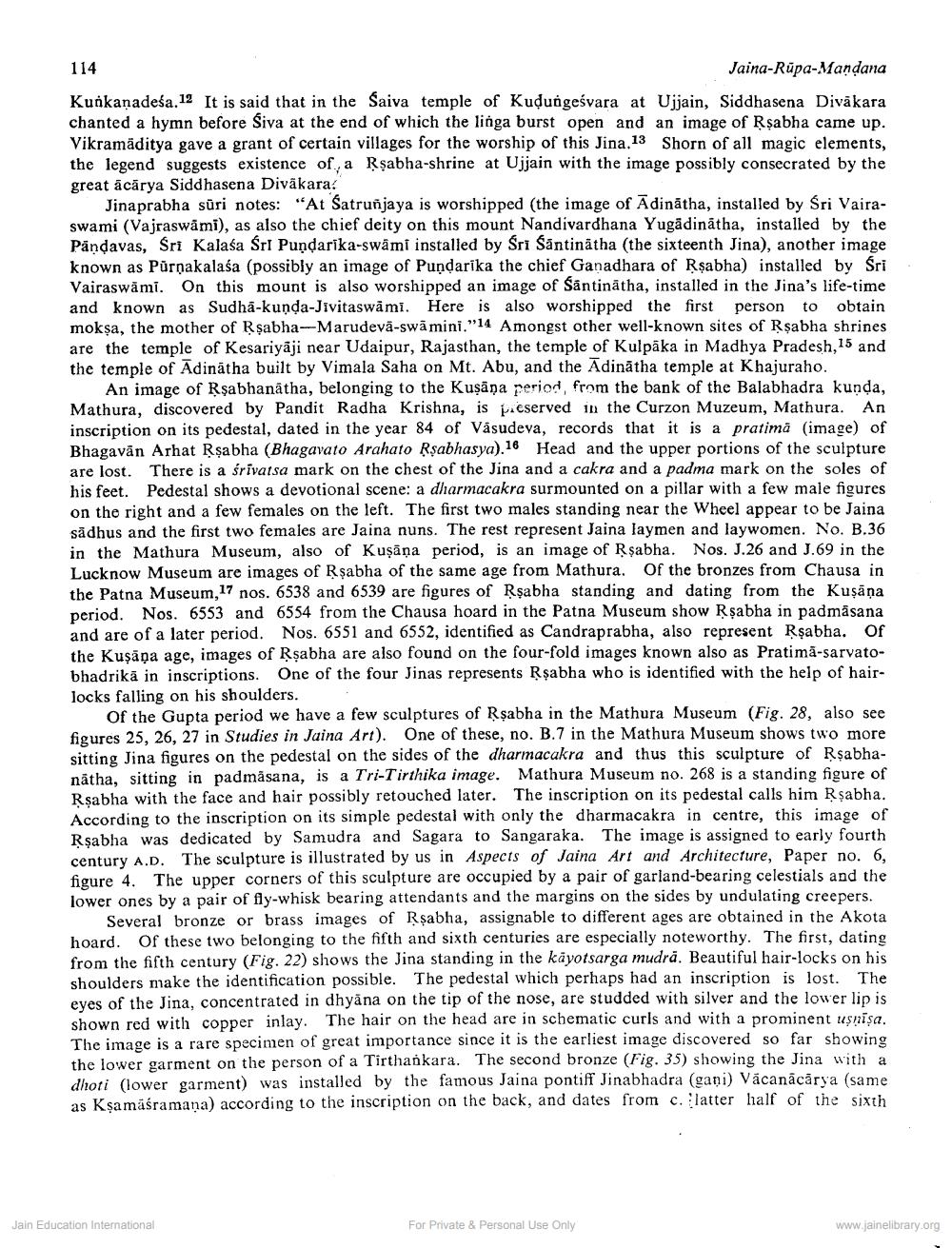________________
114
Kunkaṇadeśa.12 It is said that in the Saiva temple of Kuḍungeśvara at Ujjain, Siddhasena Divakara chanted a hymn before Śiva at the end of which the linga burst open and an image of Rṣabha came up. Vikramaditya gave a grant of certain villages for the worship of this Jina.13 Shorn of all magic elements, the legend suggests existence of, a Rṣabha-shrine at Ujjain with the image possibly consecrated by the great ācārya Siddhasena Diväkara."
Jinaprabha süri notes: "At Satrunjaya is worshipped (the image of Adinatha, installed by Sri Vairaswami (Vajraswami), as also the chief deity on this mount Nandivardhana Yugādinātha, installed by the Pandavas, Sri Kalasa Sri Puṇḍarika-swami installed by Sri Santinatha (the sixteenth Jina), another image known as Pūrṇakalasa (possibly an image of Pundarika the chief Ganadhara of Rṣabha) installed by Śri Vairaswami. On this mount is also worshipped an image of Santinatha, installed in the Jina's life-time and known as Sudha-kunda-Jivitaswami. Here is also worshipped the first person to obtain mokşa, the mother of Rṣabha-Marudeva-swamini."14 Amongst other well-known sites of Rṣabha shrines are the temple of Kesariyāji near Udaipur, Rajasthan, the temple of Kulpaka in Madhya Pradesh,15 and the temple of Adinatha built by Vimala Saha on Mt. Abu, and the Adinatha temple at Khajuraho.
An image of Rşabhanatha, belonging to the Kusana period, from the bank of the Balabhadra kunda, Mathura, discovered by Pandit Radha Krishna, is preserved in the Curzon Muzeum, Mathura. An inscription on its pedestal, dated in the year 84 of Vasudeva, records that it is a pratimă (image) of Bhagavan Arhat Rṣabha (Bhagavato Arahato Rṣabhasya). 16 Head and the upper portions of the sculpture are lost. There is a śrīvatsa mark on the chest of the Jina and a cakra and a padma mark on the soles of his feet. Pedestal shows a devotional scene: a dharmacakra surmounted on a pillar with a few male figures on the right and a few females on the left. The first two males standing near the Wheel appear to be Jaina sādhus and the first two females are Jaina nuns. The rest represent Jaina laymen and laywomen. No. B.36 in the Mathura Museum, also of Kuṣaṇa period, is an image of Rsabha. Nos. J.26 and J.69 in the Lucknow Museum are images of Rsabha of the same age from Mathura. Of the bronzes from Chausa in the Patna Museum, 17 nos. 6538 and 6539 are figures of Rṣabha standing and dating from the Kuṣāņa period. Nos. 6553 and 6554 from the Chausa hoard in the Patna Museum show Rṣabha in padmasana and are of a later period. Nos. 6551 and 6552, identified as Candraprabha, also represent Rṣabha. Of the Kuşāņa age, images of Rṣabha are also found on the four-fold images known also as Pratima-sarvatobhadrika in inscriptions. One of the four Jinas represents Rṣabha who is identified with the help of hairlocks falling on his shoulders.
Of the Gupta period we have a few sculptures of Rṣabha in the Mathura Museum (Fig. 28, also see figures 25, 26, 27 in Studies in Jaina Art). One of these, no. B.7 in the Mathura Museum shows two more sitting Jina figures on the pedestal on the sides of the dharmacakra and thus this sculpture of Rsabhanätha, sitting in padmasana, is a Tri-Tirthika image. Mathura Museum no. 268 is a standing figure of Rṣabha with the face and hair possibly retouched later. The inscription on its pedestal calls him Ṛsabha. According to the inscription on its simple pedestal with only the dharmacakra in centre, this image of Rṣabha was dedicated by Samudra and Sagara to Sangaraka. The image is assigned to early fourth century A.D. The sculpture is illustrated by us in Aspects of Jaina Art and Architecture, Paper no. 6, figure 4. The upper corners of this sculpture are occupied by a pair of garland-bearing celestials and the lower ones by a pair of fly-whisk bearing attendants and the margins on the sides by undulating creepers.
Several bronze or brass images of Rṣabha, assignable to different ages are obtained in the Akota hoard. Of these two belonging to the fifth and sixth centuries are especially noteworthy. The first, dating from the fifth century (Fig. 22) shows the Jina standing in the käyotsarga mudra. Beautiful hair-locks on his shoulders make the identification possible. The pedestal which perhaps had an inscription is lost. The eyes of the Jina, concentrated in dhyana on the tip of the nose, are studded with silver and the lower lip is shown red with copper inlay. The hair on the head are in schematic curls and with a prominent uşnişa The image is a rare specimen of great importance since it is the earliest image discovered so far showing the lower garment on the person of a Tirthankara. The second bronze (Fig. 35) showing the Jina with a dhoti (lower garment) was installed by the famous Jaina pontiff Jinabhadra (gani) Vacanācārya (same as Kṣamäśramana) according to the inscription on the back, and dates from c. latter half of the sixth
Jain Education International
Jaina-Rapa-Mandana
For Private & Personal Use Only
www.jainelibrary.org




